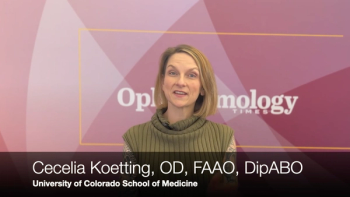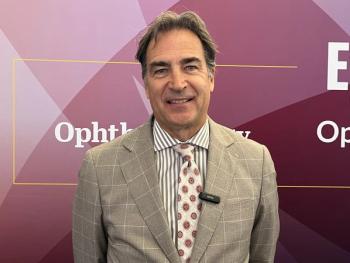
Neurostimulation in the treatment of dry eye disease
In addition to symptoms that may compromise vision, dry eye disease (DED) discomfort can be potentially detrimental to patients’ quality of life. Interventions designed to treat signs and symptoms of DED can be burdensome, especially if a multitiered approach is used.
Regimens involving any combinations of pharmacotherapy, warm compresses, supplemental tears, and omega-3 supplementation require diligence for what may seem like modest improvement. Yet, current treatment approaches can be highly effective when employed correctly. At the same time, patients and providers welcome approaches to simplify treatment.
A recent innovation in DED is said to be an effective treatment with potential to reduce reliance on pharmacotherapy. The TrueTear device (Allergan) uses neurostimulation to induce the production of basal tears, or more simply, a “real tear.”
The patient-administered device is inserted into the nose so that two prongs at the distal end approach the ophthalmic branch of the trigeminal nerve. A short electrical pulse-its strength can be attenuated by the power settings-stimulates activity within the trigeminal nerve (5V1), with additional activity to cranial nerve VII, thus innervating the lacrimal glands.
How it works
Although it might seem that using TrueTear would induce reflex tears, the resulting response is the induction of a basal tear response. The mechanism by which patients begin to produce natural tears is not yet understood. Two theories regarding the mechanism of action have surfaced:
– Stimulation of the trigeminal afferent nerve fibers in the nasal cavity via the anterior ethmoidal nerve may initiate the nasolacrimal reflex, thereby leading to “an increase in activity in the superior salivatory nucleus region of the brain, which is responsible for control of natural lacrimation.”1
– The electrical stimulus to the trigeminal afferent nerve fibers may cross over to the pterygopalatine ganglion, in turn shifting to the parasympathetic pathway to stimulate facial nerve VII that connects to goblet cells and meibomian glands.2
These two theories are not mutually exclusive, and it may be that each mechanism is partly accurate.
In the prospective, single-arm, multicenter, open-label OCUN-010 study, patients exhibited improvement on Schirmer’s testing on days 0, 7, 30, 90, and 180 compared with baseline.3
Anecdotally, I can confirm these results in patients in my clinic, with some saying they experience longer-lasting relief from symptoms related to the use of artificial tears.
Neurostimulation history
Many may recognize the concept of neurostimulation in medicine. For example, studies have described the use of neurostimulation in the management of chronic migraine pain,4 in rehabilitative settings, and for the treatment of post-traumatic stress disorder5 and cognitive neurologic conditions, such as Alzheimer’s disease.6 Neurostimulation has been used successfully for over 30 years.7
Over the years, the U.S. Food & Drug Administration has approved neurostimulation devices, including pacemakers, defibrillators, cochlear implants, and implantable devices intended to treat pain, essential tremors, refractory epilepsy, Parkinson’s disease, obsessive-compulsive disorder, obesity, and even retinitis pigmentosa.8-17Why this approach?
The science behind TrueTear provides strong rationale for its use and supports its clinical applicability. However, there may be more reasons to consider adding this device to one’s dry eye practice-especially for patients using supplemental tears.
The plethora of supplemental tear options means that each patient can likely be matched with a formulation that will provide some benefit. At the same time, artificial tears are inherently palliative. In this regard, using the TrueTear device has potential to replace artificial tears with real ones.
TrueTear can potentially be complementary to other treatments. The device is disruptive in the sense that it offers a fundamentally different mechanism of action (or perhaps multiple mechanisms), but it does not change the overall approach.
There will still be patients with underlying inflammation who will benefit from pharmacotherapy. Anything we can do to liberate patients from multiple forms of therapy is beneficial. We need only evaluate experience in treating glaucoma to note that as the regimen’s complexity increases, adherence to the regimen tends to decline. Plus, patients may realize cost benefit from avoiding drops.
Many patients may be candidates for this device. The potential to reduce dependence on other forms of therapy suggests that TrueTear may be useful for a range of patients across nearly the spectrum of DED severity. I am educating my patients with signs of DED that TrueTear may reduce or eliminate the need for supplemental tears by inducing a physiologic, natural tear.
Introducing to patients
It is worth the time to educate patients about and demonstrate its proper use. DED patients are motivated to learn about modalities that might offer symptomatic relief.
It’s important to have a device in the office to show patients its basic principles and to assuage anxieties or apprehension. Using TrueTear is similar to using a nasal spray.
Here is information to convey to patients before they start using TrueTear:
– TrueTear has been proven safe and effective in clinical trials.
– The intensity of the electrical stimulation can be modulated.
– Stimulation can be sustained for as long as the patient feels comfortable.
– TrueTear is Bluetooth-enabled; the accompanying smartphone app provides information about how often the device is used-but more importantly, it tracks the battery life (Note: the app is currently supported only on Apple devices; Allergan plans to release an Android version soon.)
It may be that using neurostimulation with patients experiencing milder forms of DED can provide long-term benefit in slowing or stopping progression. Equally as promising, it is plausible that stimulating the basal tear response might affect long-term remodeling, in effect delivering on the promise of restoring homeostasis to the ocular surface.
References:
1. Friedman NJ, et al. A nonrandomized, open-label study to evaluate the effect of nasal stimulation on tear production in subjects with dry eye disease. Clin Ophthalmol. 2016 May 4;10:795-804.
2. Hom MM, Bielory L. The anatomical and functional relationship between allergic conjunctivitis and allergic rhinitis. Allergy Rhinol (Providence). 2013 Fall;4(3):e110-e119.
3. Allergan. Allergan announces positive pivotal trial results for Oculeve intranasal tear neurostimulator [press release]. Available at: https://www.allergan.com/news/news/thomson-reuters/allergan-announces-positive-pivotal-trial-results. Accessed 3/15/17.
4. Cho SJ, Song TJ, Chu MK. Treatment update of chronic migraine. Curr Pain Headache Rep. 2017 Jun;21(6):26.
5. Sharma M, Naik V, Deogaonkar M. Emerging applications of deep brain stimulation. J Neurosurg Sci. 2016 Jun;60(2):242-255.
6. Mondragón-RodrÃguez S, Perry G, et al. Amyloid beta and deep brain stimulation: aiming to restore cognitive deficit in Alzheimer’s Disease. Curr Alzheimer Res. 2017;14(1):40-46.
7. Mekhail NA, Cheng J, Narouze S, Kapural L, Mekhail MN, Deer T. Clinical applications of neurostimulation: forty years later. Pain Pract. 2010 Mar-Apr;10(2):103-112.
8. Van Hemel NM, Van der Wall EE. 8 October 1958, D Day for the implantable pacemaker. Neth Heart J. 2008;16(suppl 1):3S-4S.
9. Benabid AL. About neuromodulation. International Neuromodulation Society. Available at: http://www.neuromodulation.com/about-neuromodulation. Accessed 9/4/16.
10. Van Welsenes GH, et al. Improvements in 25 years of implantable cardioverter defibrillator therapy. Neth Heart J. 2011;19(1):24-30.
11. National Institutes of Health. Cochlear implants. Available at: https://report.nih.gov/nihfactsheets/ViewFactSheet.aspx?csid=83. Accessed 9/4/16.
12. Rielo DA. Vagus nerve stimulation. Medscape. Available at: http://emedicine.medscape.com/article/1186123-overview. Accessed 9/4/16.
13. Karas PJ, et al. Deep brain stimulation: a mechanistic and clinical update. Neurosurg Focus. 2013 Nov;35(5):e1.
14. Gardner J. A history of deep brain stimulation: Technological innovation and the role of clinical assessment tools. Soc Stud Sci. 2013 Oct;43(5):707-728.
15. U.S. Food & Drug Administration. Reclaim DBS therapy for OCD-H050003. Available at: http://www.fda.gov/MedicalDevices/ProductsandMedicalProcedures/DeviceApprovalsandClearances/Recently-ApprovedDevices/ucm125520.htm. Accessed 9/4/16.
16. U.S. Food & Drug Administration. Argus II retinal prosthesis system-H110002. Available at: http://www.fda.gov/MedicalDevices/ProductsandMedicalProcedures/DeviceApprovalsandClearances/Recently-ApprovedDevices/ucm343162.htm. Accessed 9/4/16.
17. U.S. Food & Drug Administration. EnteroMedics Maestro rechargeable system-P130019. Available at: http://www.fda.gov/MedicalDevices/ProductsandMedicalProcedures/DeviceApprovalsandClearances/RecentlyApprovedDevices/ucm430696.htm. Accessed 9/4/16.
Newsletter
Want more insights like this? Subscribe to Optometry Times and get clinical pearls and practice tips delivered straight to your inbox.




















































.png)


